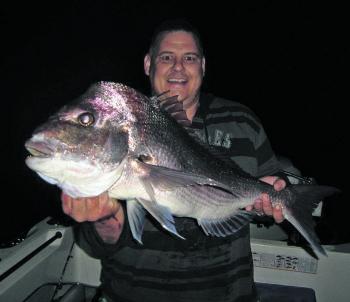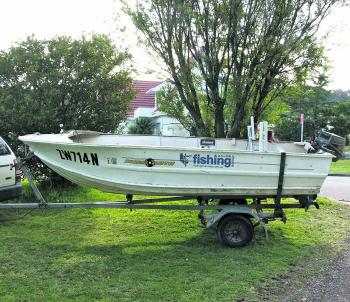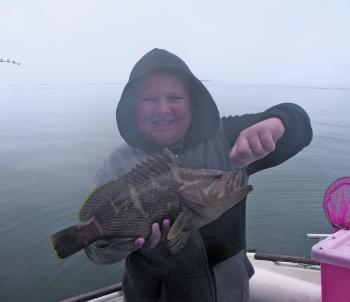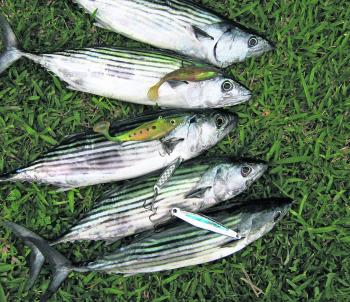We are a lucky bunch of anglers in this country. We have reefs and wrecks and undersea outcrops of rocks ranging from lone pinnacles to vast rocky stretches of bottom. Most of these features are so close to our shoreline that we can all get out to them in a reliable trailer boat, and we have a vast array of fishing technology to maximise our catch rates.
With a sounder, GPS or just your computer, there’s no reason why you can’t find close offshore reefs in your area, no matter where you are on our coastline. One look on the Internet and you can pick your own area and see what kind of structure there is and the distances involved. Once you have a starting point, you can sound around to find fish-holding structure.
Fishing has come a long way from the old days of closing one eye and lining up that mountain to that tree and that island! I remember when the old mud map from a mate who trusted you was the only way to find a speculated reef or wreck. And once you were there it was still a guessing game as to where the structure actually was. You could be 10ft off the mark and catch nothing.
Now, however, you can get to a spot and fish with confidence as we have 3D sounders, wide views of reefs and every bottom type identified, whether it’s gravel, rock, mud or sand. Over time, as you get confident with using your sounder, you may even be able to tell what species of fish are under the boat. I’ve fished with anglers who can consistently identify large mulloway, snapper or kingfish by the way they school over a reef. The way in which the fish react to the current, or how they sit on the structure being fished, is what tips these guys off. It shows the value of really learning how to use your sounder, and spending that extra time out on the water.
Once you have found your reef, wreck, pinnacle or gravel ground there are no hard and fast rules as to how you fish it. To give you a general guide, however, here’s what has worked for me and other anglers at different times.
To write about every species that turns up on the reefs would be impossible, so I will concentrate on the main species targeted by most NSW reef fishers: snapper, mulloway, bream, tailor, morwong, trevally, teraglin, nannygai, squid and kingfish. They are the most often encountered species on the close reefs on the NSW coast.
Of course there are many more species you can encounter, depending on the water temperature and other factors. I have been on reefs off Port Stephens and seen spotted mackerel, Spanish mackerel, pearl perch and mangrove jacks, mixed in with the typical schools of fish. However, I have to admit the years in which this has happened have been few and far in between. Warm currents are the major factor in the captures of more northern species in any area.
Off the NSW coast you can encounter fish which are normally considered to be rock species – drummer and groper – throughout winter and spring. They hang over reefs around 2-5km offshore. Crabs, prawns and dough or bread can take both these species offshore, and it’s best to fish for them the same way you would for snapper. A berley trail can entice fish very close to the back of your boat, and at times with bait circling in the trail you can see big predators come up as well. Kingfish and trevally are the two that seem to follow the baitfish all the way to the surface, and a rod with a lure loaded can be cast straight to them. Mahi mahi can also come in close to shore at times, and can end up in the trail. Sometimes it’s the depth rather than the distance offshore that matters.
The most popular way to fish the reefs is ‘bottom bouncing’ with a paternoster rig (typically two hooks spaced out above a snapper lead). It’s how anglers have caught bottom-dwelling fish for the last 50 years.
When it comes to bait, obviously fresh is best, but that doesn’t always mean you have to catch it yourself. At times the bait from your local servo, fish co-op or tackle shop can be really fresh and can work wonders, so don’t discount it altogether. Check it out, assess the quality and buy some if it looks good.
Some anglers won’t even think about fishing over reef without live bait, be it squid, yellowtail, yakkas, slimy mackerel, garfish, live pilchards, herring, small pike, or just legal whiting or tailor. Everyone has their own preference. I have found that if you start catching yellowtail, slimies, squid or garfish over a reef then you should use them as live bait. No matter what structure I’m fishing, I have caught most of my better fish by sourcing whatever baitfish or cephalopods I’ve found in the vicinity. They’re what the predators are feeding on, so it makes sense to use these baits – or to imitate them with a soft plastic or chrome lure. If you use a lure that’s the same size and colour as the bait the fish are feeding on, on most occasions you can’t go wrong.
Lure fishing has changed a lot. Many decades ago anglers jigged chrome lures in silver or gold colour, usually from a mate who worked in either sheet metal or steel work, as these lures weren’t available in tackle stores. Nowadays we have millions of lures to choose from and our catches have increased as a result. We can pick a lure that accurately mimics the bait the fish are feeding on – anything from a plastic crab for groper, bream and morwong through to a blue and silver lure for tailor, bream and snapper.
Soft plastics are an increasingly popular option, and they’re good to have on stand-by if the fishing is slow. They’re cheap and easy – you just drift or anchor, drop your plastic down and jig it along the bottom, lifting it sharply and then letting it flutter down. Some of the most popular plastic choices for reefies are shad-style jerk baits, curl tails and grubs, all rigged on a jighead just heavy enough to get you to the bottom in the prevailing conditions. You can even try fishing a soft plastic on a two-hook paternoster rig if you like. You can put a bait on one of the hooks and a soft plastic on the other hook, and see which gets crunched first.
Everybody has their favourite soft plastic colours, although it’s not clear whether the colour of a plastic makes a huge difference when fishing at depth.
Soft plastics aren’t the only artificials you can try though. Blades, lipless vibes, chromies and deepwater jigs all catch their fair share at different times.
When bottom bouncing you have the choice of drifting or anchoring. Drifting covers more ground, and it’s a good option if there’s a reasonable amount of structure, provided the current and wind don’t make things too tricky. The other bonus is that if you don’t catch anything, you can easily up and move somewhere else.
Anchoring is good if there’s a small amount of structure with fish hanging off it. Another plus is that you can fish lighter to get to the bottom, set out a good berley trail, and don’t have to keep moving to keep on the mark. Many anglers drift first to find the fish, and then anchor up.
Having a good sounder is essential to make sure you can see the fish and where they are hanging. At times you may have to use a heavy anchor, and you might have to anchor as far away as 30ft from the structure and use a really heavy lead to feed your bait down to the fishing zone way back from the boat. When the currents are strong, running from north to south or south to north, that has to be taken into consideration. Sometimes places can just be unfishable because of this, but at other times it can help because the fish will come closer to the surface, feeding on what’s running past them. When the current is so strong you need a house brick to get down there, it’s usually a lost cause. Moving into closer reefs can help.
Close reefs do get punished by a lot of anglers, but if you end up on them at the right time (which I admit can occasionally be just a fluke) and are happy to sit and berley, you can usually get a good bag to come home with.
When it comes to getting the ‘edge’ over other anglers, there’s no limit on what you can try. A great way I livebait is to put a large float on, and put just enough lead to get the bait to the bottom of my line. I always use a good trace. The next step is to get a 1oz snapper lead, insert it over my hook and drop it down to find the bottom, then I lift it up about 4-6ft and put a stopper knot on the line above my float and then take the snapper sinker off. This way my livebait sits up away from eels and other undesirables. The float will dance around and even get pulled down a fair way by the live bait itself, but having a loose drag will let you know when something big does come along. I have caught some nice kingfish this way as well as some good mulloway. The livey dances around distraught, putting out signals of distress, and because it’s way above the reef and snag city you have the chance of stopping the big fish ditching straight into the reef. You can put the stopper knot at any level so you can get surface feeders as well as reef feeders.
The close reefs will at times be covered in undesirable fish such as leatherjackets, sweep and yellowtail, but you can keep them out of the catch by fishing higher in the water column. If you’re using dead bait, you can fish it unweighted so it slowly drifts down under its own weight. When used in a berley trail they can be the greatest way to snag the fish. Light to medium gear is all that’s needed for this type of fishing. Just remember that floating baits do still have to be in proximity of a reef complex, and the berley trail has to be constant to lift the fish from the bottom.
No matter how you look at fishing in close, it’s a relatively safe option for anglers who are new to outside fishing and are just learning. Smaller boats can be used as long as you’re carrying the right safety equipment. I have never gone offshore without a marine radio, either a hand-held model or one fixed to the boat. On every outing you should log into to Coastal Patrol or marine rescue services, as it it not only gives you peace of mind but in the event of trouble they will be the first people you will need. It’s no good just relaying a message via a mobile phone to someone at home and having them try to contact rescue units on your behalf. Your home contact won’t be able to relay what’s happening in real time, so don’t just depend on your phone.
As I said we are pretty lucky in this country as far as reef fishing goes. Along any part of the coast you can find an array of species, so take the plunge and get amongst them.
Reads: 2495
Large snapper will readily take big baits after dark. This one grabbed a fillet of yellowtail on a paternoster rig and put up a great fight.

You don’t need a huge boat to get out to inshore rocky outcrops and reefs if you have a reliable engine and all the right safety gear. I always carry a radio and flares, and pick my days carefully.

A large blue morwong taken on a prawn dropped down over an inshore reef. Blue morwong are much better on the plate than their red cousins. They hold in schools, so if you get one you’ll usually catch more.

Squid can be put out live for kingfish, jewfish, teraglin and mahi mahi or cut up for large bream and bottom dwellers.

A close look at the lures that will entice salmon, tailor, mahi mahi, bonito, and other pelagics. You can also jig them up and down for great results.

A Maori cod taken over bumpy shallow ground. These are one of the best tasting fish in the ocean and can grow to an enormous size.

Bonito sometimes move in and take every bait when you’re fishing shallow reef, but don’t let that worry you. They are a great bait slabbed fresh or cubed and put straight back down for numerous species.

Hooked up to a rampaging small black marlin over very close reef. The best time to target them close to shore is in the middle of summer when the warmer currents are along the coast.

Mulloway love to hunt over reefs in depths of anywhere from 20-100ft, or even more. Pilchards, slabs of mullet and live baits are the go. Change of tides and moon phases can affect their movements a lot.

Salmon can come right over a reef to feed, and actually belt the hull when there are thousands of them in a feeding frenzy. Chrome lures of different sizes can take them, and they can be a lot of fun on light gear.




